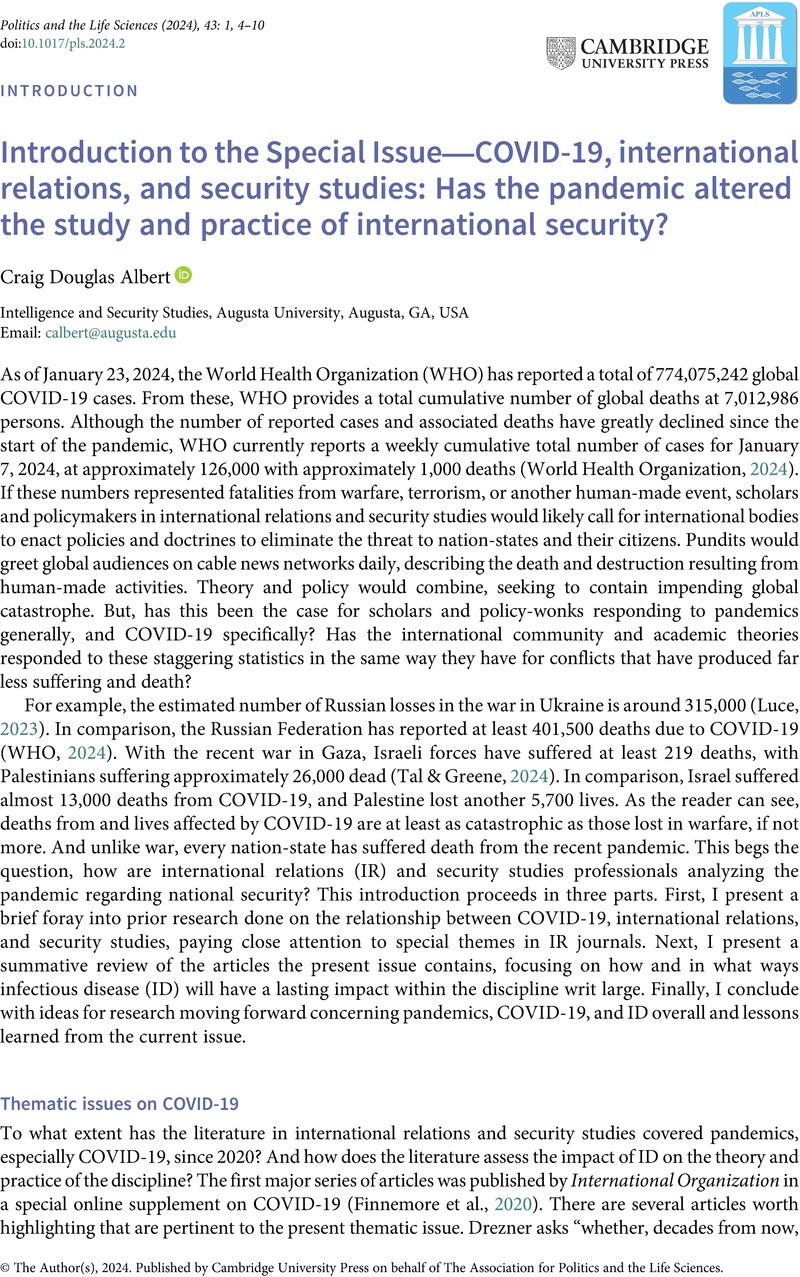No CrossRef data available.
Article contents
Introduction to the Special Issue—COVID-19, international relations, and security studies: Has the pandemic altered the study and practice of international security?
Published online by Cambridge University Press: 03 April 2024
Abstract
An abstract is not available for this content so a preview has been provided. Please use the Get access link above for information on how to access this content.

- Type
- Introduction
- Information
- Politics and the Life Sciences , Volume 43 , Special Issue 1: Infectious disease and national security special issue , Spring 2024 , pp. 4 - 10
- Copyright
- © The Author(s), 2024. Published by Cambridge University Press on behalf of The Association for Politics and the Life Sciences
References
Agostinis, G., Grépin, K. A., Kamradt-Scott, A., Lee, K., Marion, S., Worsnop, C. Z., Papagaryfallou, I., Papamichail, A., Piper, J., Rothery, F., Teh, B. C. G., Teo, T.-A., & Kim, S. Y. (2021). COVID-19 and IR scholarship: One profession, many voices. International Studies Review, 23(2), 302–345.CrossRefGoogle Scholar
Albert, C., Baez, A., & Rutland, J. (2021). Human security as biosecurity: Reconceptualizing national security threats in the time of COVID-19. Politics and the Life Sciences, 40(1), 83–105. https://doi.org/10.1017/pls.2021.1CrossRefGoogle ScholarPubMed
Albert, C. D. (2023). Epidemic intelligence studies: A research agenda for political scientists. Politics and the Life Sciences, 42(1), 158–162. https://doi.org/10.1017/pls.2023.2CrossRefGoogle ScholarPubMed
Cassario, A. (2023). Perceived vulnerability to infectious disease and perceived harmfulness are as predictive of citizen response to COVID-19 as partisanship. Politics and the Life Sciences, 42(2), 277–290. https://doi.org/10.1017/pls.2023.14CrossRefGoogle ScholarPubMed
Drezner, D. (2020). The song remains the same: International relations after COVID-19. International Organization, 74(S1), E18–E35.CrossRefGoogle Scholar
Dunne, T., Hansen, L., & Wight, C. (2013). The end of international relations theory? European Journal of International Relations, 19(3), 405–425. https://doi.org/10.1177/1354066113495485CrossRefGoogle Scholar
Finnemore, M., Horowitz, M. C., Scheve, K., Schultz, K., & Voeten, E. (Eds.) (2020). IO COVID-19 online supplemental issue. International Organization, 74(S1). https://www.cambridge.org/core/journals/international-organization/issue/23C8E56F7F03EA9CAF5E1A63EFCABFE5Google Scholar
Greitens, S. C. (2020). Surveillance, security, and liberal democracy in the post-COVID world. International Organization, 74(S1), E169–E190.CrossRefGoogle Scholar
Koong, A., McDermott, R., & Kaplan, R. (2023). Examining American attitudes toward vaccination during the COVID-19 pandemic from the perspective of negative and positive rights. Politics and the Life Sciences, 42(2), 291–305. https://doi.org/10.1017/pls.2023.17CrossRefGoogle ScholarPubMed
Kosal, M. (2024). How COVID-19 is reshaping U.S. national security policy. Politics and the Life Sciences, 43(1), 83–98.CrossRefGoogle Scholar
Luce, D. D. (2023). Russia has suffered dramatic casualties in Ukraine, U.S. intelligence says. NBC News. https://www.nbcnews.com/news/world/russia-suffered-dramatic-casualties-ukraine-us-intelligence-says-rcna129354Google Scholar
McDermott, R. (2024). The politics of disease. Politics and the Life Sciences, 43(1), 11–23.CrossRefGoogle Scholar
Stasavage, D. (2020). Democracy, autocracy, and emergency threats: Lessons for COVID-19 from the last thousand years. International Organization, 74(S1), E1–E17.CrossRefGoogle Scholar
Sterling-Folker, J., Freyberg-Inan, A., Wilcox, L., Oxguc, U., & Shinko, R. E. (2021). Forum: Thinking theoretically in unsettled times: COVID-19 and beyond. International Studies Review, 23(3), 1100–1125.CrossRefGoogle Scholar
Stevens, D., Banducci, S., & Horvath, L. (2024). Authoritarianism, perceptions of security threats, and the COVID-19 pandemic: A new perspective. Politics and the Life Sciences, 43(1), 60–82.CrossRefGoogle Scholar
Tal, A., & Greene, R. A. (2024). 24 soldiers killed on deadliest day for Israeli forces in Gaza combat. CNN. https://www.cnn.com/2024/01/23/middleeast/gaza-israeli-soldiers-deaths-intl-hnk/index.htmlGoogle Scholar
Topping, K., Hosny, Y., Hunter, L. Y., & Yang, Y. (2024). The effects of COVID-19 on domestic and international security in democratic and authoritarian regimes. Politics and the Life Sciences, 43(1), 34–59.CrossRefGoogle Scholar
Walker, C. P., & Cramer, E. R. (2024). Contagion to Unrest: investigating the link between disease and civil unrest in Africa. Politics and the Life Sciences, 43(1), 24–33.CrossRefGoogle Scholar
World Health Organization. (2024). COVID-19 Data Dashboard. https://data.who.int/dashboards/covid19/casesGoogle Scholar




